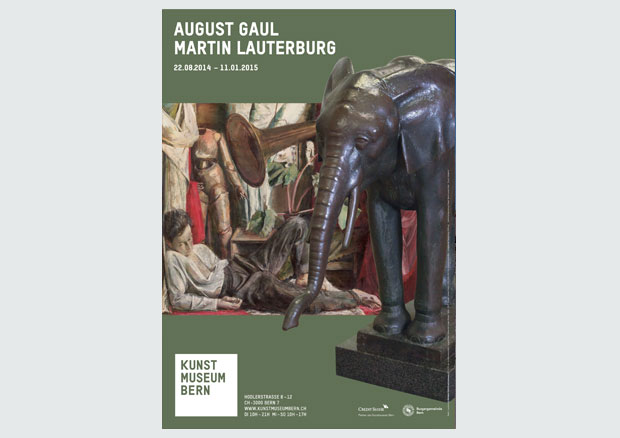New Additions to the Collection: August Gaul and Martin Lauterburg, 22.08.2014 - 11.01.2015
Of Penguins and Geraniums
The Kunstmuseum Bern is welcoming the addition to its collection of two extensive groups of works by the artists August Gaul and Martin Lauterburg. The Zwillenberg Foundation (Bern) handed over its outstanding collection of some 120 sculptures of animals by the German sculptor August Gaul (1869-1921) as a permanent loan to the Kunstmuseum Bern. Our presentation provides a cohesive picture of the oeuvre of the artist, who was one of the pioneers of modern German sculpture working in Berlin at the beginning of the 20th century. The second addition is due to the Martin Lauterburg Foundation transferring its collection to that of the Kunstmuseum Bern Foundation. It comprises some 80 paintings as well as numerous prints, drawings, and photographs by the Bernese painter Martin Lauterburg (1891-1960). Together with works by Lauterburg that were already part of the Kunstmuseum Bern collection, we are presenting a selection of his oeuvre so that our audience can rediscover this unique artist who was once greatly esteemed for his magical realism.
Our presentation combines the works of both artists, although each has separate rooms. It provides our visitors with the opportunity of encountering two remarkably different artists, each of whom produced an innovative and convincing oeuvre in his respective genre.
August Gaul as Pioneer
of Modern Sculpture
August Gaul is one of the pioneers of modern sculpture in Germany. It was
his legacy that, as subject matter, animals became just as accepted as human
figures. He executed monumental sculptures in stone and bronze as well as many
pieces in small and very small formats. From 1893 onwards Gaul chose to mainly
depict animals. He found his models in the Berlin Zoo and Natural History
Museum, first making sketches of them and often modelling maquettes directly on
location. He became well-known among private collectors and museums after
participating in the Paris World's Fair in 1900. Appreciation of this artist
was enhanced by the proactive marketing efforts undertaken by the gallery owner
Paul Cassirer. Gaul was a founding member of the Berlin Secession, a group of
artists associated with the painter Max Liebermann.
From 1900 onwards, the Jewish Zwillenberg-Tietz family, Berlin-based entrepreneurs, began accruing an art collection in which also works by August Gaul found a prominent place. After marrying Elise Tietz in 1919, Hugo Zwillenberg entered the retail business of his father-in-law Oscar Tietz. On Hitler coming to power in 1933 and in the course of Nazi “Aryanization,” the family was forced to sell the company and its department stores, which was then renamed “Hertie.” Together with other artworks and furniture, the family managed to have the Gaul Collection transported out of Germany, so that it survived the war in the free port of Amsterdam. The family was always committed to preserving their collection of 120 sculptures as a whole, making it today one of the largest surviving Gaul collections. The daughter Dr. Helga Zwillenberg (1930-2013) and son Dr. Lutz Zwillenberg (1925–2011) lived in Bern from 1959 onwards, where they established the Zwillenberg Foundation in 2012 to preserve their collection of Gaul’s sculptures. In the summer of 2013, the Zwillenberg Foundation handed over its holdings of Gaul's art to the Kunstmuseum Bern as a permanent loan.
Martin Lauterburg: An Eminent Painter
between Realism and Imagination
Martin Lauterburg was born on May 14, 1891, in Neuenegg and spent his
childhood in a public orphanage in Bern after his father died early. He attended the
grammar school Freies Gymnasium, and the landscape painter Ernst Linck gave him
his first art lessons.
In 1910 Lauterburg traveled to Munich, where he studied at the College
of Applied Arts and became a member of the New Secession group of artists. In 1935 he returned
to Bern and lived in the Länggass Quarter until his death on June 9, 1960.
Although not many people remember Lauterburg today, during his lifetime he was highly esteemed as an artist in both Switzerland and Germany. His unconventional style is strongly expressionistic while likewise often divulging the influence of the old masters. In the exhibition we are presenting a selection of works from the Martin Lauterburg Foundation, which was established in 1973 and transferred to the Kunstmuseum Bern Foundation this summer. Works by the artist already belonging to the Kunstmuseum Bern Collection will supplement this selection. Among the 35 paintings and a dozen drawings and photographs, the exhibition includes the flower still lifes of an artist who was renowned as the "geranium painter" as well as portraits (Ricarda Huch et al.), cityscapes and landscapes, religious works, and, not least, a series of compositions featuring his studio and depicting the artist in the midst of props that seem strangely alive. In these paintings, Lauterburg proves a veritable precursor of performance art. The artist would often stage himself in cleverly devised photographs that he took as a preliminary step leading to paintings. In various guises as a modern-day sorcerer’s apprentice, the artist depicts himself surrounded by poseable dolls and masks in claustrophobic interiors, addressing the fragility and ambiguity of human existence. As a painter, but also as a still-little researched photographer, Lauterburg explored the interplay of animate and inanimate things. In this way he developed his own style of magic realism that is still highly relevant today.
Contact person: Brigit Bucher, , Tel.: +41
31 328 09 21
Images: Marie Louise Suter, , Tel.: +41
31 328 09 53


